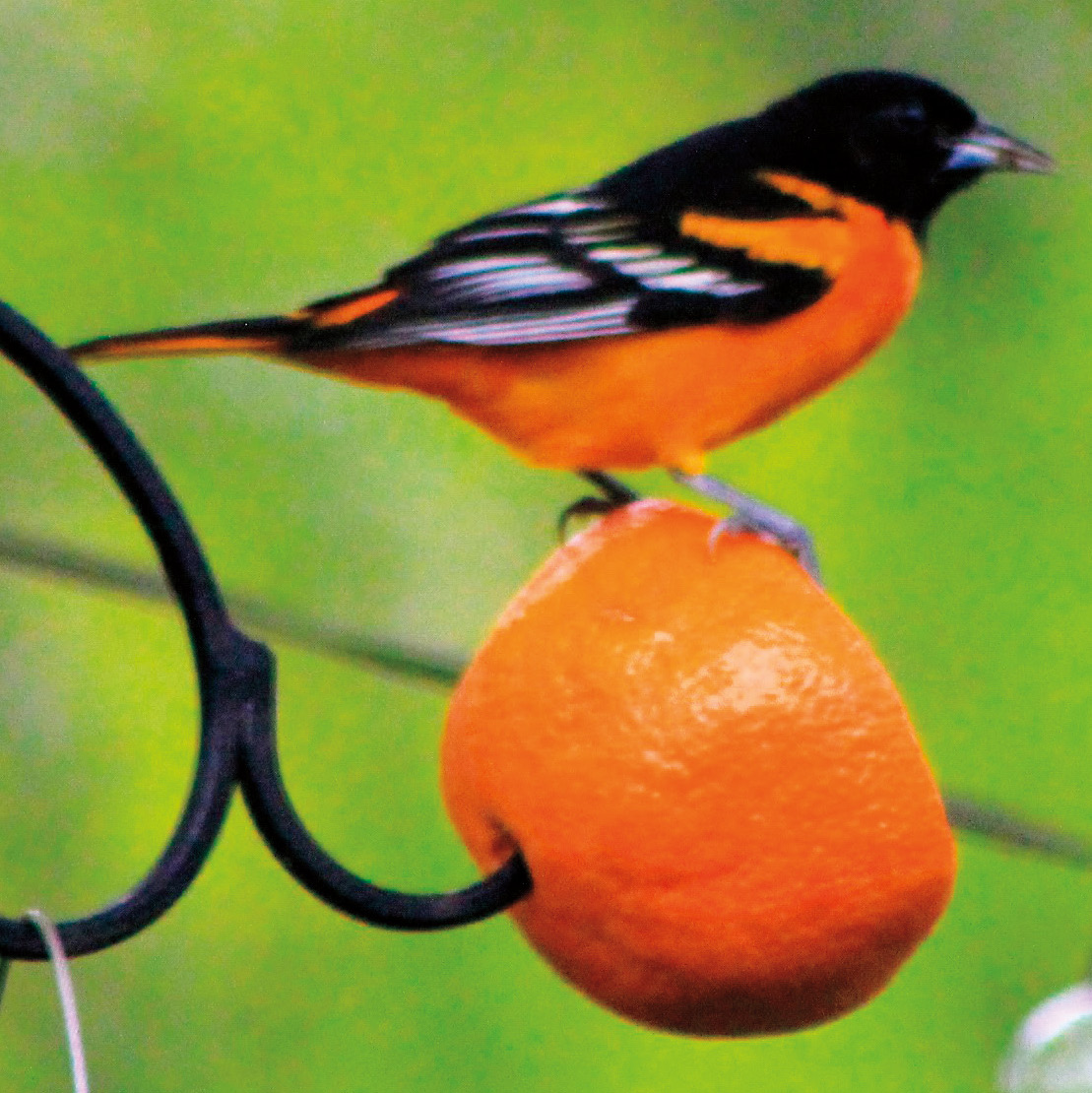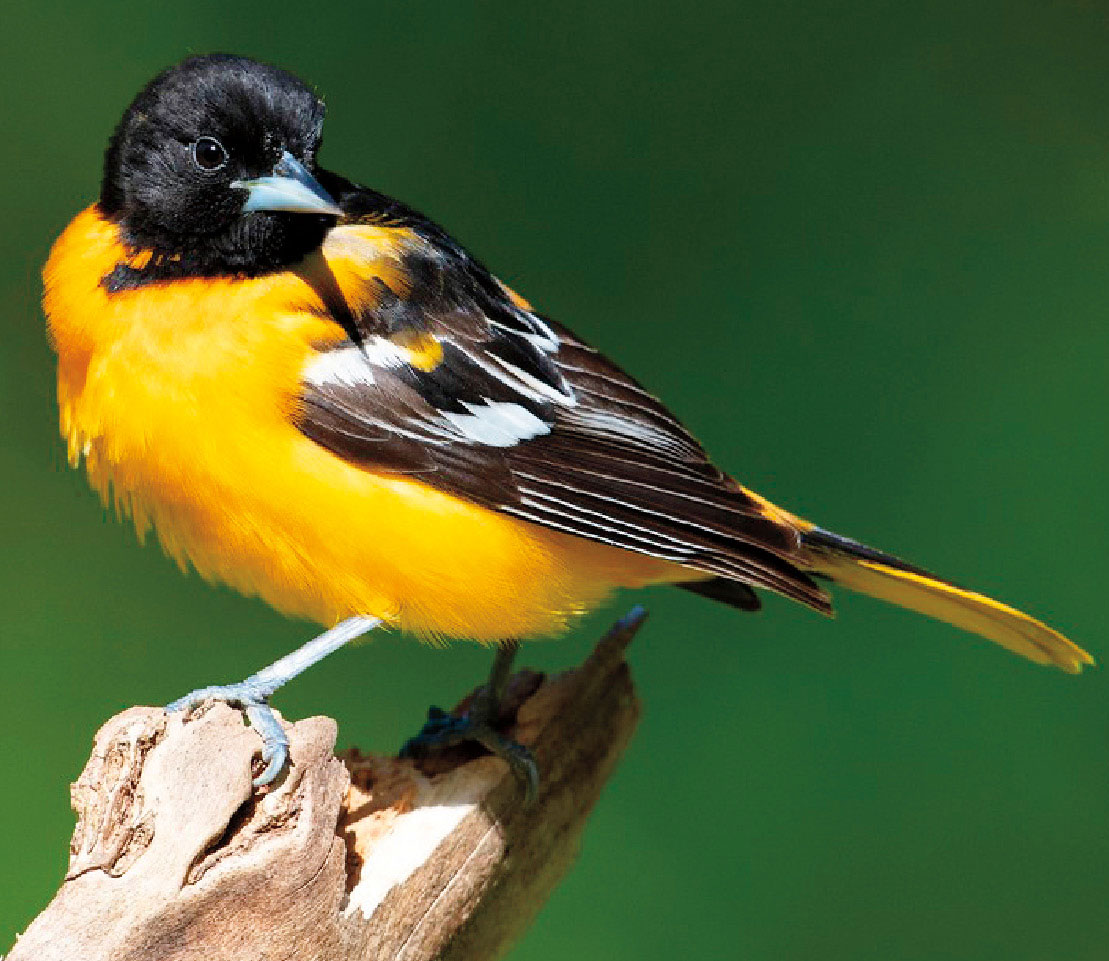The Birders’ Dozen
Profile: Baltimore Oriole
Welcome to the Birders’ Dozen! Over the next several issues, we are going to continue introducing the bird species from Forestry for the Birds. The Birders’ Dozen are forest birds that can benefit from targeted management practices, as most are declining due to habitat loss. We’ve curated this list to cover a wide range of habitat types, from young to mature forest, open to closed canopy, or dense to non-existent shrub layers. Our goal is to engage landowners and foresters in the process of managing forests for wildlife, or “forests for the birds.” Baltimore Oriole on a backyard bird feeder with oranges, image courtesy Jessica Outcalt.
Baltimore Oriole on a backyard bird feeder with oranges, image courtesy Jessica Outcalt.
This is the third iteration of this series, in which we’ll meet a bird that is not traditionally associated with forest, but still depends on it – the Baltimore Oriole. One of the best-loved and most sought-after species at backyard bird feeders, the Baltimore Oriole is a strikingly charismatic woodland species. Though orioles are opportunistic species that can utilize a wide range of habitats, their continent-wide population has been declining significantly in the last several decades. However, targeted management on backyard and forest-level scales can benefit these beautiful birds.
Natural History
The Baltimore Oriole’s preferred breeding habitat is open areas, orchards, riparian woodlands, and similar deciduous habitats. They often nest in large or isolated trees such as elm, sycamore, or cottonwoods. The nest is usually built high off the ground, far from predators, in the outer branches of the tree. Orioles weave unique gourd-shaped nests out of hair, string, or plant fibers. Generally the female only builds this nest, and lays a clutch of 3-7 small, cream-colored eggs once it’s complete and she’s found her mate. She alone will incubate the eggs for 11-14 days, then both parents will feed the nestlings for another two weeks until they fledge.
These bright orange and black birds often forage high in large trees or on fruit-bearing shrubs. Their primary foods are soft invertebrates like caterpillars and plant matter such as fruits and nectar. This diet follows a seasonal pattern: invertebrates are the most important food source during the breeding season, when developing young depend on protein, while fruits and nectar are more important during migration when birds need fat for fuel. It is possible that, due to these food preferences, orioles are sensitive to effects of insecticides and herbicides sprayed in woodland, edge, or orchard areas. Baltimore Oriole, image courtesy Matt Williams Nature Photography.
Baltimore Oriole, image courtesy Matt Williams Nature Photography.
Baltimore Orioles spend the winter in Florida, the Caribbean, Central America, and the northernmost portions of South America. Habitats during migration are generally similar to habitats used during the breeding season, though orioles and many other migratory birds can be more generalistic during the migratory period. Spring migration in Indiana generally happens in late April and May, while fall migration ends around Labor Day. Orioles seem to follow a loop migration pattern, where they migrate over the Gulf of Mexico during spring migration, but take the “long way around” over land via Mexico during fall migration. During the winter, orioles are found in a variety of habitats such as woodlands, gardens, and even shaded coffee and cacao plantations.
Habitat Management
Management that creates open woodland habitats and leaves large, isolated trees such as oak, elm, sycamore, and cottonwoods standing can benefit oriole populations. Management or enhancement of riparian and wetland areas in particular can greatly benefit oriole populations; maintenance of large trees along creeksides is one way to provide oriole nesting habitat. Orioles often utilize edge habitats, which are prone to invasion from non-native species like bush honeysuckle. Management plans that target prevention and removal of these plants can help enhance the landscape to provide orioles with better nesting habitat and better-quality fuel sources such as dogwood berries during migration. In addition, orioles are susceptible to predation by domestic cats, given their proximity to human communities, and can benefit from simple actions such as landowners keeping their cats inside.
Because orioles consume a large amount of fruits and nectar, oranges and grape jelly are common additions to backyard bird feeder set-ups. If you choose to feed birds in your backyard, simply follow a few guidelines and you’ll be able to enjoy orioles and many other feeder favorites. In particular, the National Audubon Society recommends feeding a variety of seeds, suet, nectar, and fruit to encourage diversity, cleaning feeders regularly to prevent spread of disease, placing feeders either within three feet or greater than twenty-five feet away from windows to prevent collisions, and keeping your cats inside to prevent mortality from predation.
Finally, the Baltimore Oriole is one bird in our set of twelve species that can be protected even from your breakfast table. Many coffee beans are grown in Central and South America, where a large portion of our migratory birds spend their winters. Agroforestry programs such as shade coffee plantations can provide wintering habitat for migratory birds like Baltimore Orioles; landowners can benefit these charismatic species through even the coffee they drink. The Smithsonian’s National Zoo and Conservation Biology Institute provides a “Bird Friendly” certification program that supports sustainable agroforestry initiatives that benefit our birds, even when they’re hundreds of miles away.
Conclusion
While many of the birds on our Birders’ Dozen list are forest specialists, often depending on specific management practices in large tracts of forest, we wanted to include a bird that even a landowner with one or two trees on their property could still benefit. Oriole management can happen across a wide range of scales, from a single tree in a backyard to large tracts of forest, and can even be benefitted from simple choices consumers can make. We hope that Forestry for the Birds can be an inclusive tool for all woodland landowners, to benefit both birds with more complex habitat requirements, like the American Woodcock we introduced last issue, as well as generalist birds that might come to backyard feeders, like the Baltimore Oriole.
Special thanks to the Alcoa Foundation, the Indiana Forestry Educational Foundation, and The Nature Conservancy for their support and leadership of Forestry for the Birds.
References
Greenberg, Russell, Peter Bichier, and John Sterling. 1997. “Bird Populations in Rustic and Planted Shade Coffee Plantations of Eastern Chiapas, México.” Biotropica 29 (4): 501–14. https://doi.org/10.1111/j.1744-7429.1997.tb00044.x.
National Audubon Society. 2011. “11 Tips for Feeding Backyard Birds.” https://www.audubon.org/news/11-tips-feeding-backyard-birds.
Rising, James D., and Nancy J. Flood. 2020. “Baltimore Oriole (Icterus Galbula).” Birds of the World, March. https://birdsoftheworld.org/bow/species/balori/cur/introduction.
Smithsonian’s National Zoo and Conservation Biology Institute. 2022. “About Bird Friendly Coffee.” https://nationalzoo.si.edu/migratory-birds/about-bird-friendly-coffee.
